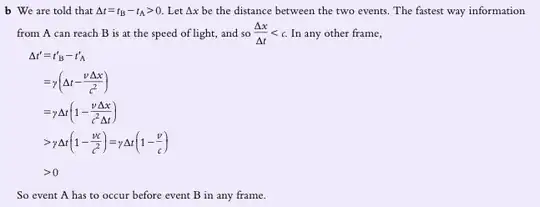I am trying to work through a proof of causality in special relativity using the Lorentz transformations, but there is one assumption that is necessary for the proof that I don't see as correct.
The question I am working on specifically asks: "In frame S, event A causes event B and therefore occurs before event B. Show that in any frame, event A always occurs before event B." I have understood the proof except for one assumption: "The fastest way information from A can reach B is at the speed of light, so Δx/Δt < c". Why is it not $Δx/Δt ≤ c$? I know that if I use this latter assumption, then the proof doesn't really work, as it results in the possibility that the causal event in the S frame could look like a simultaneous event in the S' frame, but I don't see why my assumption is wrong.
I came up with a simple thought experiment: say event A is the firing of a photon at a target one lightsecond away; event B is the reception of that photon one second later. This gives Δt=1 s, Δx=3*10^8 m, and so Δx/Δt = c. If I plug this in, however, another observer would measure Δt'=0, so they would see the two events happen simultaneously, which breaks (or at least muddies) causality.
Where did I go wrong in my thinking?
EDIT: here is a photo of the proof (it comes from the Cambridge Physics IB textbook):
I understand all the math and substitutions, but I think that the inequality should be Δx/Δt ≤ c, which would lead to a final conclusion of Δt'≥0.
